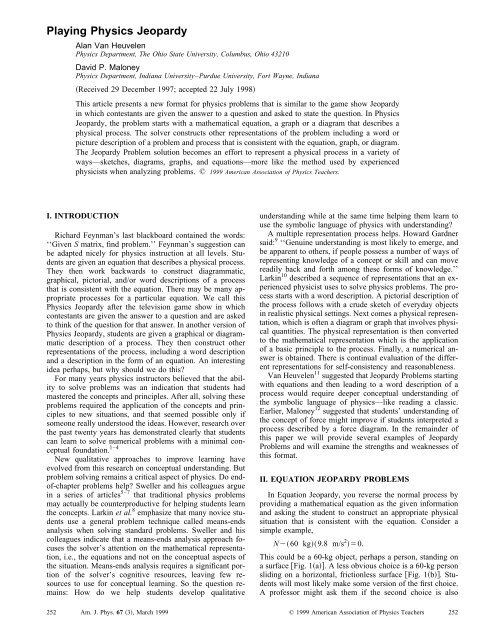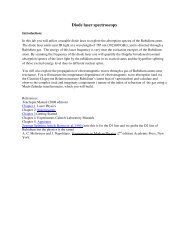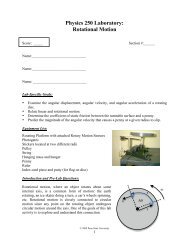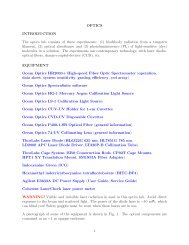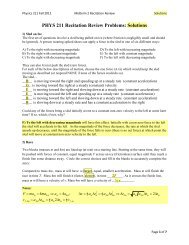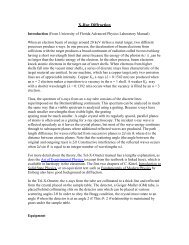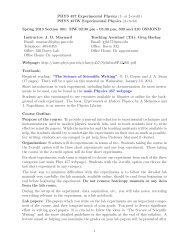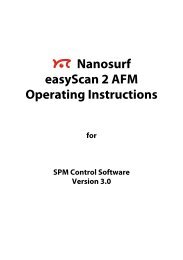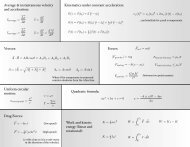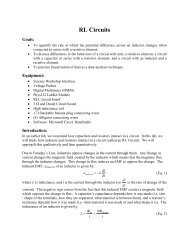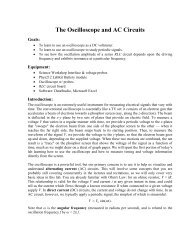Playing Physics Jeopardy
Playing Physics Jeopardy
Playing Physics Jeopardy
You also want an ePaper? Increase the reach of your titles
YUMPU automatically turns print PDFs into web optimized ePapers that Google loves.
<strong>Playing</strong> <strong>Physics</strong> <strong>Jeopardy</strong><br />
Alan Van Heuvelen<br />
<strong>Physics</strong> Department, The Ohio State University, Columbus, Ohio 43210<br />
David P. Maloney<br />
<strong>Physics</strong> Department, Indiana University–Purdue University, Fort Wayne, Indiana<br />
Received 29 December 1997; accepted 22 July 1998<br />
This article presents a new format for physics problems that is similar to the game show <strong>Jeopardy</strong><br />
in which contestants are given the answer to a question and asked to state the question. In <strong>Physics</strong><br />
<strong>Jeopardy</strong>, the problem starts with a mathematical equation, a graph or a diagram that describes a<br />
physical process. The solver constructs other representations of the problem including a word or<br />
picture description of a problem and process that is consistent with the equation, graph, or diagram.<br />
The <strong>Jeopardy</strong> Problem solution becomes an effort to represent a physical process in a variety of<br />
ways—sketches, diagrams, graphs, and equations—more like the method used by experienced<br />
physicists when analyzing problems. © 1999 American Association of <strong>Physics</strong> Teachers.<br />
I. INTRODUCTION<br />
Richard Feynman’s last blackboard contained the words:<br />
‘‘Given S matrix, find problem.’’ Feynman’s suggestion can<br />
be adapted nicely for physics instruction at all levels. Students<br />
are given an equation that describes a physical process.<br />
They then work backwards to construct diagrammatic,<br />
graphical, pictorial, and/or word descriptions of a process<br />
that is consistent with the equation. There may be many appropriate<br />
processes for a particular equation. We call this<br />
<strong>Physics</strong> <strong>Jeopardy</strong> after the television game show in which<br />
contestants are given the answer to a question and are asked<br />
to think of the question for that answer. In another version of<br />
<strong>Physics</strong> <strong>Jeopardy</strong>, students are given a graphical or diagrammatic<br />
description of a process. They then construct other<br />
representations of the process, including a word description<br />
and a description in the form of an equation. An interesting<br />
idea perhaps, but why should we do this?<br />
For many years physics instructors believed that the ability<br />
to solve problems was an indication that students had<br />
mastered the concepts and principles. After all, solving these<br />
problems required the application of the concepts and principles<br />
to new situations, and that seemed possible only if<br />
someone really understood the ideas. However, research over<br />
the past twenty years has demonstrated clearly that students<br />
can learn to solve numerical problems with a minimal conceptual<br />
foundation. 1–4<br />
New qualitative approaches to improve learning have<br />
evolved from this research on conceptual understanding. But<br />
problem solving remains a critical aspect of physics. Do endof-chapter<br />
problems help? Sweller and his colleagues argue<br />
in a series of articles 5–7 that traditional physics problems<br />
may actually be counterproductive for helping students learn<br />
the concepts. Larkin et al. 8 emphasize that many novice students<br />
use a general problem technique called means-ends<br />
analysis when solving standard problems. Sweller and his<br />
colleagues indicate that a means-ends analysis approach focuses<br />
the solver’s attention on the mathematical representation,<br />
i.e., the equations and not on the conceptual aspects of<br />
the situation. Means-ends analysis requires a significant portion<br />
of the solver’s cognitive resources, leaving few resources<br />
to use for conceptual learning. So the question remains:<br />
How do we help students develop qualitative<br />
understanding while at the same time helping them learn to<br />
use the symbolic language of physics with understanding?<br />
A multiple representation process helps. Howard Gardner<br />
said: 9 ‘‘Genuine understanding is most likely to emerge, and<br />
be apparent to others, if people possess a number of ways of<br />
representing knowledge of a concept or skill and can move<br />
readily back and forth among these forms of knowledge.’’<br />
Larkin 10 described a sequence of representations that an experienced<br />
physicist uses to solve physics problems. The process<br />
starts with a word description. A pictorial description of<br />
the process follows with a crude sketch of everyday objects<br />
in realistic physical settings. Next comes a physical representation,<br />
which is often a diagram or graph that involves physical<br />
quantities. The physical representation is then converted<br />
to the mathematical representation which is the application<br />
of a basic principle to the process. Finally, a numerical answer<br />
is obtained. There is continual evaluation of the different<br />
representations for self-consistency and reasonableness.<br />
Van Heuvelen 11 suggested that <strong>Jeopardy</strong> Problems starting<br />
with equations and then leading to a word description of a<br />
process would require deeper conceptual understanding of<br />
the symbolic language of physics—like reading a classic.<br />
Earlier, Maloney 12 suggested that students’ understanding of<br />
the concept of force might improve if students interpreted a<br />
process described by a force diagram. In the remainder of<br />
this paper we will provide several examples of <strong>Jeopardy</strong><br />
Problems and will examine the strengths and weaknesses of<br />
this format.<br />
II. EQUATION JEOPARDY PROBLEMS<br />
In Equation <strong>Jeopardy</strong>, you reverse the normal process by<br />
providing a mathematical equation as the given information<br />
and asking the student to construct an appropriate physical<br />
situation that is consistent with the equation. Consider a<br />
simple example,<br />
N60 kg9.8 m/s 2 0.<br />
This could be a 60-kg object, perhaps a person, standing on<br />
a surface Fig. 1a. A less obvious choice is a 60-kg person<br />
sliding on a horizontal, frictionless surface Fig. 1b. Students<br />
will most likely make some version of the first choice.<br />
A professor might ask them if the second choice is also<br />
252 Am. J. Phys. 67 3, March 1999<br />
© 1999 American Association of <strong>Physics</strong> Teachers 252
volume must be 1.7810 3 m 3 or greater. The student must<br />
also think about units and conversions because the volume is<br />
given in the equation in m 3 , but the question asks for the<br />
volume in liters.<br />
Consider a <strong>Jeopardy</strong> Problem involving the component<br />
form of Newton’s second law applied to an object on an<br />
incline,<br />
Fig. 1. The equation N(60 kg)(9.8 m/s 2 )0 describes the situations<br />
shown in a and b.<br />
appropriate—an opportunity to confront a common student<br />
alternative belief.<br />
The first example is quite simple. More challenging <strong>Jeopardy</strong><br />
Problems can be created with relative ease. Take a standard<br />
problem and use a basic principle to write an equation<br />
that describes the problem process. Consider the following<br />
examples that represent either the description of a process at<br />
one instant of time or a continuous process with a beginning<br />
and an end the initial and final states of the process. An<br />
example of the latter is shown below with the left side of the<br />
equation representing the initial state and the right side the<br />
final state,<br />
1/26000 N/m2.00 m 2 72 kg9.8 m/s 2 17 m.<br />
The 1/2 times a number with units N/m times the square of a<br />
distance causes an experienced physicist to think of the elastic<br />
potential energy of a stretched or compressed spring. On<br />
the right side of the equation we have gravitational potential<br />
energy with a mass, the acceleration due to gravity and a<br />
distance height. If the left side is the initial energy and the<br />
right side the final energy, the process might involve an ejector<br />
seat with a compressed spring launching a 72-kg object<br />
another person upward a maximum distance of 17 m. There<br />
could of course be other processes described by the equation,<br />
such as a compressed spring launching the object up a frictionless<br />
incline so that the total change in elevation is 17 m.<br />
Students are encouraged to think divergently when inventing<br />
processes described by the equations.<br />
A <strong>Jeopardy</strong> Problem representing a steady state process is<br />
shown below:<br />
12 VI1/5 6 1/8 1 14 .<br />
The task here is to draw an electric circuit. Once again the<br />
student must translate a mathematical relation into a reasonable<br />
physical situation—in this case a diagram rather than a<br />
verbal statement.<br />
Consider a <strong>Jeopardy</strong> Problem that is followed by a series<br />
of questions to help students develop better conceptual understanding,<br />
1.39 kg9.8 m/s 2 <br />
780 kg/m 3 9.8 m/s 2 1.7810 3 m 3 0.<br />
After students decide that the equation describes an object<br />
floating in some liquid, which is not water, we might ask<br />
additional questions. What is the liquid? What is the volume<br />
of the floating object in liters? This latter question requires<br />
the student to realize that the 1.7810 3 m 3 in the right<br />
term of the equation is a lower limit for the volume of the<br />
object. The object would be in neutral buoyancy if immersed<br />
to its full volume and still ‘‘floating.’’ Since the 1.78<br />
10 3 m 3 is the lower limit for the object’s volume, the<br />
150 N14.5 kg9.8 m/s 2 sin 34°0.3214.5 kg<br />
9.8 m/s 2 cos 34°14.5 kga x .<br />
With a little work, a physicist will recognize that something<br />
exerts a 150-N force parallel to a 34° incline while pulling<br />
or pushing a 14.5-kg object up the incline. There is friction<br />
with a 0.32 kinetic friction coefficient between the object and<br />
the inclined surface. This <strong>Jeopardy</strong> Problem is somewhat<br />
more challenging. We can ask the students to translate from<br />
the mathematical representation to a physics sketch, a freebody<br />
diagram in this case, and then from the diagram to a<br />
picture-like sketch of an appropriate physical situation. Finally,<br />
students could be asked to invent a word problem that<br />
is consistent with the equation.<br />
<strong>Jeopardy</strong> Problems can be constructed for all physics subjects.<br />
For example, students might be given an application of<br />
the first law of thermodynamics (QUW) for an ideal<br />
gas, where W is the work done by the system:<br />
Q8.0 mol8.31 J/mol K361 Kln34.3 L/60 L.<br />
The students would either be asked to describe a physical<br />
process for which the equation applies or to answer a variety<br />
of questions such as the following. What type of process is<br />
this? How do you know? What are the volumes and pressures<br />
for the initial and final states of the process? What<br />
actually happened to the gas during the process? Did the gas<br />
do work during the process? Explain. By how much did the<br />
internal energy of the gas change during the process? Was<br />
there heat transfer to or from the gas?<br />
As another example, we might ask students to draw a<br />
sketch that represents a process described by the following<br />
equation suggested by F. Munley:<br />
1.510 6 N1.010 5 Cv0.010 T0.50.<br />
This could be the magnetic force exerted on a charged object<br />
moving at 30 m/s relative to a magnetic field. Why the 0.50<br />
at the end of the equation? The student needs to consider the<br />
relative directions of the magnetic field and the velocity.<br />
A more complex problem provides the coupled equations<br />
that result from the application of Newton’s law to a system<br />
of objects connected together by ropes and moving as one.<br />
Consider the equations below:<br />
T 1 0.1528 kg9.8 m/s 2 28 kga x ,<br />
T 2 T 1 0.1571 kg9.8 m/s 2 71 kga x ,<br />
T 3 T 2 0.1548 kg9.8 m/s 2 48 kga x .<br />
Similar multiple-equation problems can be constructed for<br />
many other physics concepts: systems of static electric<br />
charges; systems in static equilibrium; the application of<br />
Kirchhoff’s rules to an electric circuit; kinematics equations<br />
for multiobject systems a truck passing a car at a stop sign<br />
or a multipart single-object problem with different accelerations<br />
in each part for example, a bottle rocket’s vertical<br />
flight.<br />
253 Am. J. Phys., Vol. 67, No. 3, March 1999<br />
A. Van Heuvelen and D. P. Maloney 253
Fig. 2. The free-body diagram shown in a represents the process shown in<br />
b.<br />
III. DIAGRAM AND GRAPH JEOPARDY PROBLEMS<br />
In Diagrammatic and Graphical <strong>Jeopardy</strong> Problems, students<br />
are first given a diagram or graph. They then invent a<br />
word or picture description and a math description for a process<br />
that is consistent with the diagram or graph. Consider<br />
the force diagram in Fig. 2a. Tell as much about the situation<br />
as you can.<br />
The force diagram could describe a box or block moving<br />
downward at constant velocity along a vertical wall Fig.<br />
2b. The normal force indicates that the object is pressed<br />
against a vertical wall. The kinetic friction force indicates<br />
that the object is moving down. Notice that the y components<br />
of the forces parallel to the wall’s surface add to zero. This<br />
provides a nice opportunity to confront the common belief<br />
misconception that there must be a net force in the direction<br />
of motion in order for that motion to continue.<br />
In another problem, students are given a position-versustime<br />
graph Fig. 3. They then construct a motion diagram, a<br />
velocity-versus-time graph, and an acceleration-versus-time<br />
graph—all consistent with the position-versus-time graph.<br />
Finally, they invent a process that is consistent with all of<br />
these descriptions. Other types of <strong>Jeopardy</strong> Problems can<br />
start with a graph. For example, we might provide a graph of<br />
magnetic flux-versus-time or of the electric potential energy<br />
of a particle in an electric field as a function of time.<br />
Energy bar charts lend themselves nicely to this type of<br />
<strong>Jeopardy</strong> Problems. The bar chart shown in Fig. 4 indicates<br />
that the system starts with considerable elastic energy (U s )<br />
and ends with kinetic energy K and gravitational potential<br />
Fig. 3. Invent a process that is consistent with the kinematic position-vstime<br />
graph.<br />
Fig. 4. A qualitative work-energy bar chart—what’s the process?<br />
energy (U g ). One possible process would be a compressed<br />
spring that launches an object up an incline or straight up<br />
into the air. The object has some speed and kinetic energy at<br />
the final state of the process. Students must understand the<br />
meaning of the different types of energy in order to invent a<br />
process that is consistent with the bar chart.<br />
IV. SIMULATION JEOPARDY PROBLEMS<br />
All of these types of <strong>Jeopardy</strong> Problems can be used with<br />
simulations. For an Equation <strong>Jeopardy</strong> Problem, the student<br />
is first given an equation that describes a physical process.<br />
After students invent their own process, they can be shown a<br />
simulation that is one physical process that is consistent with<br />
the equation—there could be other processes. In a Graphical<br />
or Diagrammatic <strong>Jeopardy</strong> Problem, the student might see a<br />
kinematics graph or a work-energy bar chart that evolves<br />
with time on the simulation screen. The student then invents<br />
a process that is consistent with the graph or bar chart. Finally,<br />
a version of the simulation is run that shows one possible<br />
process that is consistent with the graph or bar chart.<br />
These types of activities can be produced with Interactive<br />
<strong>Physics</strong> 13 and are included in Activ<strong>Physics</strong>. 14<br />
V. STRENGTHS AND WEAKNESSES OF JEOPARDY<br />
PROBLEMS<br />
If one of our instructional goals is to promote problem<br />
solving with understanding, <strong>Jeopardy</strong> Problems have several<br />
strengths. First, students often think of traditional physics<br />
problem solving as a process for finding the right equation.<br />
For <strong>Jeopardy</strong> Problems, students cannot use formulacentered,<br />
plug-and-chug problem-solving methods. Instead,<br />
they must give meaning to the symbols in the equations and<br />
to the diagrams and graphs. They must visualize a process<br />
that is consistent with the equation, diagram, or graph. The<br />
equations, diagrams, and graphs become short stories about<br />
life. The mathematical relations in Equation <strong>Jeopardy</strong> Problems<br />
are models of physical situations rather than just something<br />
into which students plug numbers.<br />
A second strength of these problems is that units become<br />
more meaningful since they become the key to determining<br />
what physical quantities are involved. If we are dealing with<br />
the pressure in a standing fluid, then the quantities that will<br />
appear in one or more of the terms in the equation will be<br />
density, acceleration due to gravity, and a distance. The units<br />
are the key to recognizing each of these quantities. Consequently,<br />
the units become useful sources of information.<br />
254 Am. J. Phys., Vol. 67, No. 3, March 1999<br />
A. Van Heuvelen and D. P. Maloney 254
A third strength of these problems is that they help the<br />
students learn to translate between representations in a more<br />
robust manner. By robust we mean that they develop a stronger<br />
understanding of each representation—the verbal problem<br />
statement, the everyday picture-like representation, the<br />
physics representation, and the mathematical equation. They<br />
also learn to convert one representation into another and in<br />
any direction. To do this, each representation must have<br />
meaning for the student.<br />
A fourth strength of these problems is that they are easy to<br />
create. All you need is an existing problem from the back of<br />
the chapter of a physics book. Simply apply in equation form<br />
the fundamental principle needed to solve the problem. You<br />
have a <strong>Jeopardy</strong> Equation Problem. Or construct a diagram<br />
or graph that describes the problem. You have a <strong>Jeopardy</strong><br />
Diagram or Graph Problem.<br />
A fifth strength of <strong>Jeopardy</strong> Problems depends on their use<br />
in homework assignments and on tests. If students realize<br />
that <strong>Jeopardy</strong> Problems will appear on tests, the students are<br />
encouraged to think more deeply about standard end-ofchapter<br />
problems and to use multiple representations of<br />
physics processes to describe these problems.<br />
A weakness of <strong>Jeopardy</strong> Problems stems from the fact that<br />
they are novel for students. Any new problem format has<br />
some learning associated with it that is independent of the<br />
particular problem content. Students develop mechanisms for<br />
coping with free response, multiple choice, and essay questions<br />
on tests. They need practice with <strong>Jeopardy</strong> Problems<br />
before they are used on tests. It is important to start with<br />
relatively easy one-equation examples so students develop<br />
skill at solving such problems.<br />
There might also be concern about grading these problems.<br />
The authors find them easier to grade than standard<br />
problems presented in a free-response format. For <strong>Jeopardy</strong><br />
Problems, students present diagrams, graphs, bar charts, and<br />
sketches as part of the solution—seldom seen with traditional<br />
problems. The problems can even be presented in a<br />
multiple choice format by asking students to choose the one<br />
of five versions of one representation for example, five<br />
graphs that best matches the description of a situation in the<br />
form of another representation for example, an equation.<br />
VI. IMPACT ON STUDENT LEARNING<br />
The authors use one or more pedagogical innovations in<br />
their courses Active Learning Problem Sheets, Context-Rich<br />
Problems, Activ<strong>Physics</strong> interactive simulations, Ranking<br />
Tasks, and <strong>Jeopardy</strong> Problems. It is difficult to say what<br />
impact any one of these innovations has on student learning<br />
as measured by various types of tests. The widely used Mechanics<br />
Baseline Test MBT, a problem-solving test with a<br />
strong conceptual base, might be one of the better measures<br />
of students’ ability to use the math language of physics with<br />
understanding—a main goal for using <strong>Jeopardy</strong> Problems.<br />
During the last two years, one author AVH has taught<br />
calculus-ready freshmen engineers—honors students in their<br />
engineering course. <strong>Jeopardy</strong> Problems were used routinely<br />
on their tests. They scored 78 on the MBT during the winter<br />
of 1997 and 77 during the fall 1997. These scores are equal<br />
to and perhaps slightly higher than the best scores reported<br />
by Hake for 3259 students from different colleges, including<br />
a prestigious Ivy League university. 15 The fall 1997 class<br />
scored 86 on the Force Concept Inventory Test, a qualitative<br />
reasoning test concerning mechanics. Representing physical<br />
processes in multiple ways, including the use of <strong>Jeopardy</strong><br />
Problems, we believe has a very positive effect on students’<br />
ability to use the math language of physics with understanding.<br />
What do students say about <strong>Jeopardy</strong> Problems? One of us<br />
DVM has used <strong>Jeopardy</strong> Problems as homework assignments<br />
in a calculus-based introductory physics course. At the<br />
end of each semester, he asks students to identify the five<br />
homework assignments from which they learned the most<br />
and the five assignments from which they learned the least,<br />
and to explain why. One class was also asked to identify the<br />
advantages and disadvantages of each problem type. <strong>Jeopardy</strong><br />
Problems were identified as difficult. Several student<br />
comments follow:<br />
‘‘The advantage of this type of homework was the use<br />
of looking at equations and seeing how they apply in<br />
the real world.’’<br />
‘‘I spent a very long time on this one, repeated it over<br />
and over. I think because it gave the force equations and<br />
ask to draw free body diagrams and a physical situation<br />
it forced me to analyze the equations until I knew exactly<br />
what everything meant.’’<br />
‘‘Even though I hated this one, it made me think ... a<br />
lot. Instead of just giving me the situation and asking<br />
me to find the answer, you turned the tables and had me<br />
work through the situation the opposite way I normally<br />
would have. I had to use the equations and come up<br />
with a reasonable physical situation and this was you<br />
could say rather ‘stimulating.’ ’’<br />
Learning to read with understanding the equations of physics<br />
is a challenging task for our students and a task that is not<br />
addressed by typical end-of-chapter problems.<br />
VII. SUMMARY AND CONCLUSION<br />
This article has presented a new format for physics problems.<br />
The format essentially reverses the usual solution sequence<br />
by providing the mathematical equation as the starting<br />
point, normally the next to last point of the solution<br />
process. Solvers then construct from the equation one, or<br />
more, of the following: a physics representation, an everyday<br />
picture-like representation, or a verbal description of the<br />
physical situation. Other versions of <strong>Jeopardy</strong> Problems start<br />
with diagrams, graphs, or bar charts. A wide variety of problems<br />
can be developed using this format. These problems<br />
range in difficulty from reasonably straightforward to very<br />
complex. The format is useful in all topic domains of physics<br />
and at all levels of physics—remember Feynman’s S-matrix<br />
problem.<br />
The value of this problem format is that it helps students<br />
develop a new perspective for both the problem-solving process<br />
and for the use of different representations to model<br />
physical processes. The equation description of a process is<br />
now regarded more as a short story about some aspect of<br />
life—about a physical process—and less as a set of symbols<br />
that must be solved numerically to answer a question. The<br />
problem solution becomes an effort to represent a physical<br />
process in a variety of ways—sketches, diagrams, graphs,<br />
and equations—more like the method used by experienced<br />
physicists when analyzing problems. <strong>Jeopardy</strong> Problems help<br />
students develop a better understanding and appreciation for<br />
the representations needed to solve problems with understanding.<br />
255 Am. J. Phys., Vol. 67, No. 3, March 1999<br />
A. Van Heuvelen and D. P. Maloney 255
1 J. Clement, ‘‘Students’ Preconceptions in Introductory Mechanics,’’ Am.<br />
J. Phys. 50, 66–71 1982.<br />
2 I. A. Halloun and D. Hestenes, ‘‘The Initial Knowledge State of College<br />
<strong>Physics</strong> Students,’’ Am. J. Phys. 53, 1043–1055 1985.<br />
3 P. C. Peters, ‘‘Even Honors Students Have Conceptual Difficulties with<br />
<strong>Physics</strong>,’’ Am. J. Phys. 50, 501–508 1982.<br />
4 L. C. McDermott, ‘‘Millikan Lecture 1990: What we teach and what is<br />
learned—closing the gap,’’ Am. J. Phys. 59, 301–315 1991.<br />
5 J. Sweller, R. F. Mawer, and M. R. Ward, ‘‘Development of Expertise in<br />
Mathematical Problem Solving,’’ J. Exp. Psychol. 112, 639–661 1983.<br />
6 J. Sweller, ‘‘Cognitive Load During Problem Solving: Effects on Learning,’’<br />
Cogn. Sci. 12, 251–285 1988.<br />
7 M. Ward and J. Sweller, ‘‘Structuring Effective Worked Examples,’’<br />
Cogn. Instruc. 7, 1–39 1990.<br />
8 J. H. Larkin, J. McDermott, D. P. Simon, and H. A. Simon, ‘‘Expert and<br />
Novice Performance in Solving <strong>Physics</strong> Problems’’ Science 208, 1335–<br />
1342 1980.<br />
9 H. Gardner, The Unschooled Mind: How Children Think and How Schools<br />
Should Teach Basic Books, New York, 1991, p.13.<br />
10 J. Larkin, ‘‘The Role of Problem Representations in <strong>Physics</strong>,’’ in Mental<br />
Models, edited by D. Genther and A. L. Stevens Erlbaum Associates,<br />
Hillsdale, NJ, 1983.<br />
11 A. Van Heuvelen, ‘‘ ‘What’s the Problem?’ Problems,’’ Announcer 23, 80<br />
1993.<br />
12 D. P. Maloney, ‘‘Forces as Interactions,’’ Phys. Teach. 28, 386–390<br />
1990.<br />
13 Knowledge Revolution, Interactive <strong>Physics</strong> 3.0, San Mateo, CA 1996.<br />
14 A. Van Heuvelen, Activ<strong>Physics</strong> 1 Addison–Wesley, Menlo Park, CA,<br />
1997.<br />
15 Richard R. Hake, ‘‘Interactive-engagement versus traditional methods: A<br />
six-thousand student survey of mechanics test data for introductory physics<br />
courses,’’ Am. J. Phys. 66, 64–74 1998.<br />
PITY THE POOR OBSERVER<br />
My search consisted mainly of concerning any physicist I chanced to meet at a cocktail party<br />
and asking, ‘‘Why is it so important to know the exact speed of light?’’<br />
Most of the answers only puzzled me. One was that the speed of light is one of the few<br />
‘‘constants’’ in nature, unaffected by the motion of the source of light or that of the observer.<br />
What observer, I wondered. I was to hear a lot about this unfortunate creature before I had<br />
finished. He was forever on board a train, going toward nowhere in particular, and never even<br />
allowed to comment upon the phenomena he observed. Aristotle stood him on the earth, Copernicus<br />
and Kepler put him up in the sky, and Einstein had him locked in an elevator, plunging down<br />
an endless shaft.<br />
Dorothy Michelson Livingston, The Master of Light—A Biography of Albert A. Michelson The University of Chicago<br />
Press, Chicago, 1973, pp. 5–6.<br />
256 Am. J. Phys., Vol. 67, No. 3, March 1999<br />
A. Van Heuvelen and D. P. Maloney 256


